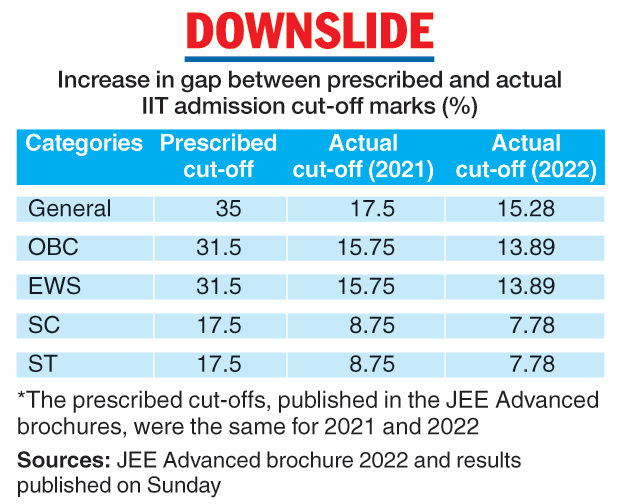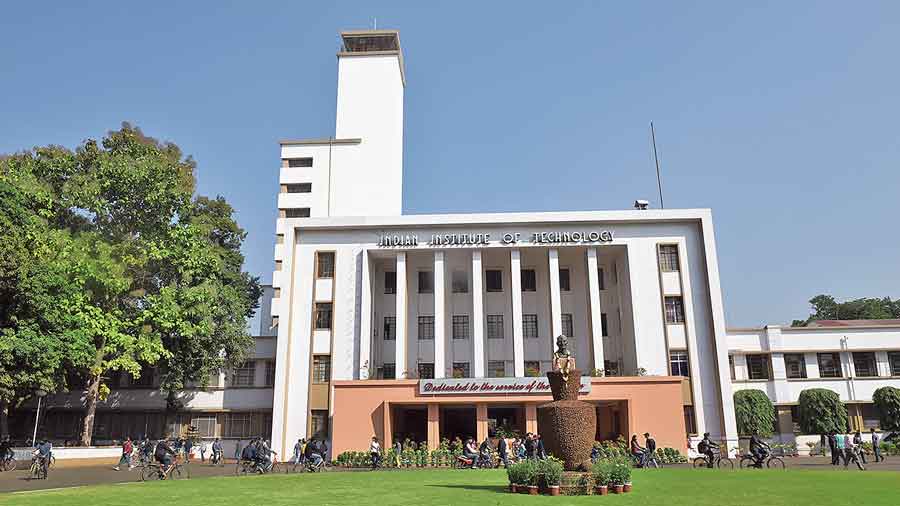The cut-off marks used by the IITs for BTech admission have dipped further this year from an already record-equalling low last year, suggesting a post-Covid decline in student performance.
Some 40,712 candidates, including 6,516 female students, have been declared as qualified in this year’s Joint Entrance Examination (JEE) Advanced, whose results were released on Sunday.
The information brochure for this year’s JEE Advanced had prescribed 35 per cent aggregate marks as the cut-off for the general category; 31.5 per cent for the Economically Weaker Sections (EWS) and Other Backward Classes (OBC) categories, and 17.5 per cent for the Scheduled Caste (SC) and Scheduled Tribe (ST) categories.
But generally poor results in the JEE Advanced have forced the institutes to lower the cut-offs by more than 55 per cent in each category to maintain the preferred ratio of 2:1 between the number of qualified candidates and the number of seats on offer.
This ratio is deemed optimum to fill the 16,000 BTech seats the 23 IITs offer, since not all the courses are in equal demand and the students have the option of choosing the NITs, private colleges or foreign institutions.
The actual cut-offs used this year are 15.28 per cent for the general category, 13.89 per cent for the OBC and EWS categories and 7.78 per cent for the SC and ST categories. These cut-offs are lower than those used last year which, at 50 per cent dilution, were already a record. (See chart)

The brochure also prescribed subject-wise cut-offs. General candidates needed to obtain 10 per cent each in mathematics, physics and chemistry while the benchmark was 9 per cent for the OBC and EWS and 5 per cent for the SCs and STs.
After last year’s JEE Advanced, the subject-wise cut-offs had to be lowered to half the prescribed level, that is, 5 per cent, 4.5 per cent and 2.5 per cent. This year, the subject-wise cut-offs were reduced further to 4.4 per cent for the general category, 4 per cent for the OBCs and EWS, and 2.2 per cent for the SCs and STs.
Debashish Chakravarty, a faculty member at IIT Kharagpur, attributed the forced lowering of the cut-offs to the Covid-induced hurdles to school education, such as classroom closures and online learning. He said the standard and pattern of the questions had not changed.
“The last two years have been a very troubled period for students. Schools and colleges were closed and the students mainly studied online, which is not very effective,” Chakravarty said.
The prescribed cut-offs have been the same for many years, and till 2017 the IITs stuck to them. But in June 2018, the number of qualified candidates fell below the 2:1 ratio. The then human resource development ministry directed the IITs to increase the number of qualified candidates to maintain the ratio for every category.
In 2018 and 2019, the aggregate cut-offs were lowered by about 30 per cent -- to 25 per cent for the general category, 22.5 per cent for the OBCs (and the EWS which was introduced in 2019), and 12.5 per cent for the SCs and STs. The subject-wise cut-offs were not reduced.
In 2020 and 2021, the aggregate and subject-wise cut-offs were slashed by half in each category.
This year’s brochure too mentioned that the cut-offs could be lowered if necessary.
“The IITs want enough students to qualify so that their seats would not go vacant,” former NIT Warangal director G.R.C. Reddy said.
“Some courses are in high demand but certain others are not. A larger pool of qualified candidates helps in such situations.”
Subhasis Chaudhari, director of IIT Bombay which organised the JEE Advanced this year, played down the lowering of the cut-offs and any suggestion of a fall in standards.
“If you see the (actual) cut-offs of recent years, the IITs have been lowering them to half the prescribed level. This year, there’s a further one to two per cent dip. Depending on the question papers and performance, this much deviation is normal,” Chaudhuri said.
“I am personally very happy at the average performance of the students this year as the question papers were claimed to be tougher by all.”
R.K. Shishir has topped the JEE Advanced this year by scoring 314 out of 360 marks. About 1.55 lakh students took the exam.
According to a media release from the IITs, some 15,111 candidates made it to the general category list, followed by 9,205 on the OBC list, 4,979 on the EWS list, 7,984 on the SC list and 3,058 on the ST list. A total of 375 disabled students too have qualified.












